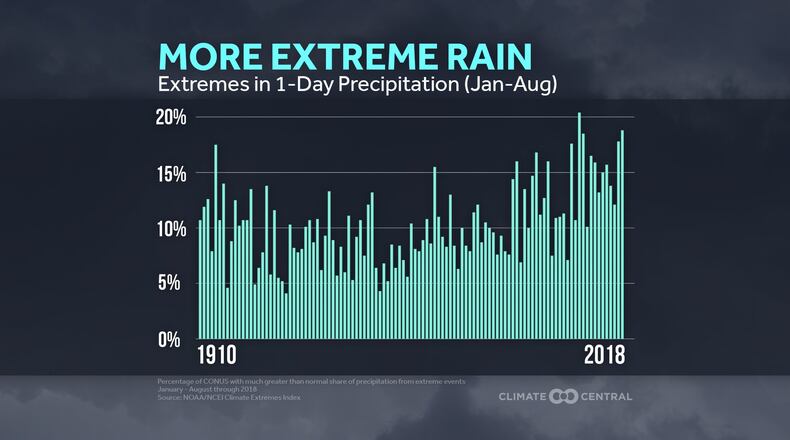In this cycle, the water goes through different forms: liquid, solid (ice) and vapor. The processes within that cycle are evaporation, evapotranspiration (water evaporated directly of plants and trees) followed by condensation, precipitation or sublimation.
TRENDING: Fatal Kettering house explosion’s cause ‘undetermined’
The water cycle is constantly in action across the earth. It is the most basic process of weather on earth, and the only planet we know of where this process exists.
But recently, we’ve seen the water cycle seemingly get out of whack. Precipitation events have become more extreme, leading to increasing amounts of flooding. The likely reason for increased high-precipitation events is the global temperatures that are on the rise because of our changing climate.
The science is quite conclusive that global average temperatures are on the rise. It is a fact that 9 of the top 10 hottest years for the planet have all occurred since the year 2000. The hottest year on record was 2016. Last year took the No. 3 spot.
Here in the Miami Valley, many will remember how hot 2012 was … but, interestingly enough, that year did not make it into the top 10 globally.
MORE: 5 throwback restaurants to visit if you want a little nostalgia
So, what does the temperature of the planet have to do with the water cycle? It is quite simple, actually. Simply put, warmer air can hold more water, although the process is a bit more complicated than that.
It is more factual to say that warmer air can “transport” more water than colder air. The warmer the temperature, the easier water can evaporate into the air. That water can then be “unloaded” by storm systems that are also more intense due to the warm temperatures.
This summer has brought flooding to several parts of the U.S.
Pennsylvania had its wettest summer on record, and the neighboring states of Maryland, Virginia, and West Virginia each had one of their 10 wettest summers on record.
Just this past weekend, Wilmington, North Carolina, broke a record for the wettest year ever recorded with more than 100 days left to go. It was just last year when the heaviest rainfall event on record occurred near Houston, Texas, thanks to Hurricane Harvey. More than 60 inches of rain fell in just a few days, which created catastrophic flooding.
TRENDING: What Urban Meyer said on his first day back
While there are multiple conditions necessary for hurricanes to form, the energy that sustains these powerful storms comes from the warm ocean water. More than 90 percent of the warming from human-induced climate change has gone into the global oceans, raising water temperatures 2°-4°F over the past century. That has translated to warming in the tropical Atlantic and along the U.S. coasts.
As warming of the climate system continues, an increase in the number of tropical cyclones each year is not necessarily expected, but their effects will be magnified. Studies have shown that climate change enhanced the rain totals from Hurricane Harvey last year, and rising seas drove the storm surge from Sandy farther inland in 2012. With sea levels projected to rise at least a few more feet by the end of the century, storm surge will push even farther inland, affecting more people and doing more damage.
If you need more evidence that the water cycle may be in overdrive, just look at the chart produced by an independent organization of leading scientists and journalists from Climate Central. Using data from the National Oceanic and Atmospheric Administration and the National Center for Environmental Information (NOAA/NCEI), there is clear evidence that there is an increase in high precipitation events in the United States. Not only is there an increase in the number of excessive precipitation events, but the percentage of landmass in the U.S. that experiences these events has expanded from 10 percent to 15 percent in in the last 18 years.
The good news is, at least for now, the tropics have become less active than they were just a week ago. Unfortunately, hurricane season still has more than 2 months to go. While I hope there are no more big storms anytime soon, the truth is, the chances the next storm will break records is increasing each year as temperatures rise.
About the Author
